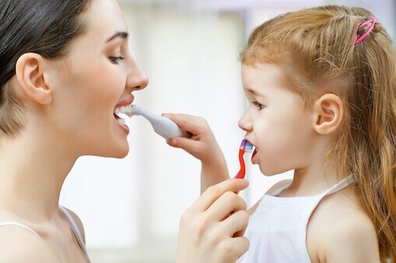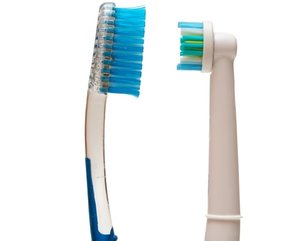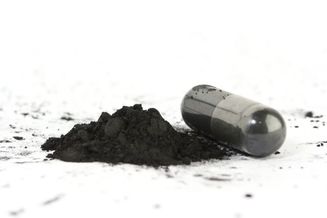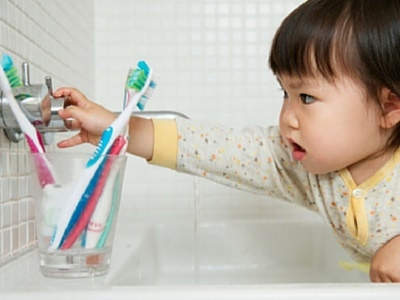 For almost two years, you have been holding the toothbrush for him. Because he is now a toddler, it’s time to pass the torch and train your little tot to brush his teeth by himself. Ever since he had his baby teeth, you have probably been telling him to open his mouth wide while you brush his increasing number of tiny pearls. And by now, he probably learned the brushing routine. He had seen you how to wet the toothbrush, watched the amount of toothpaste to squeeze out, and even tried his best to spit into the sink. At this point, you may decide to let him be independent, to give your young one the responsibility of scrubbing and cleaning his own teeth. However, even if you are ready to give up control of the morning and bedtime ritual of tooth brushing, your toddler may not be so keen to do it on his own. If he resists, try this tooth brushing training tips to ease him into doing it.
 Anything that will improve your child’s interest in tooth brushing is definitely a welcome idea, and this include an electric toothbrush, according to the American Academy of Pediatric Dentistry (AAPD). However, there are advantages and disadvantages to this. One things, a manual toothbrush may actually provide a more efficient result since you scrub back and forth and touch several tooth at once. Electrical brushes, particularly the type with the circular heads, hit only one tooth at a time, but on the upside, it may do a more thorough job, especially if your little tot is patient. So, which toothbrush wins in this battle? The answer: both types do fine ways to clean, you only have to find out which suits better with your child. However, there is another thing to consider, though. When choosing a toothbrush for your young one, whether its electric or manual, keep these things in mind:
It is good to allow your little one to weigh in on his dental care purchases. He will be more motivated to use his toothbrush he actually likes, and also the toothpaste in his favourite flavour. However, do not expect him to brush his teeth with a smile after each meal. Sometimes, he will fuss and fidget, particularly when you insist to do the scrubbing (which you should do until they are seven to ensure their teeth are thoroughly cleaned and scrubbed). Be persistent yet gentle and do whatever you can to help make the process faster. Below are some helpful ideas:
 Thinking of using charcoal to whiten your child’s teeth or remove tooth stains? More and more people are trying this trend, believing that charcoal could absorb toxins, bacteria and even stains on the teeth. Believers of activated charcoal for teeth whitening brush their teeth using this material for 3 to 5 minutes and then claiming she had seemingly whiter teeth. Warning Against Charcoal Whiteners Your teeth could be stained or discoloured due to a number of factors, from the food you eat to poor dental hygiene. Say for instance, if you eat blueberry, your teeth could be stained blue. Those are the kind of stains that they believe if you brush with charcoal, you can clean off. However, medical professionals warn against the use of do-it-yourself tooth whitening that may lead to deterioration of tooth enamel and tooth erosion. Activated charcoal can cause a potential damage due to its grainy substance. Dentists fear that people will use charcoal often, causing too much erosion on the tooth enamel. What’s worse is that it can eventually lead to deeper erosion as the material works into the deeper layer of the tooth which is the dentin. Unlike skin or hair, dentin does not heal itself or grow back. Due to the abrasiveness of charcoal, it could even leave teeth stained, blotchy and prone to erosion and deterioration later on. Though some users find charcoal as effective for whitening, the long-term effect of teeth whitening is still unknown. In addition, there is no solid evidence that activated charcoal does any benefit to your teeth. Activated charcoal should not replace daily tooth brushing and flossing as well as regular dental visits. These two ways – brushing and flossing – are necessary to remove plaque. The toothpaste you are using provides fluoride for the teeth. From a dentist’s perspective, it is concerning that people use products without fluoride. How About Charcoal Toothpaste? There’s no scientific proof that activated charcoal truly works. In fact, there are far better options that do actually work. If you desire a pearly white smile, dentists recommend using traditional toothpaste to erase surface stain or common treatment procedures for deeper stains. Don’t forget, if it sounds too good to be true, it probably is. Still, any conventional whitening toothpastes or visiting a dentist are advised as they are safer. Take note that there are numerous products that can be very abrasive. Mint Kids Dentistry suggests to ask you dentist and calculate the risk before you try any latest trend. For now, if you are searching for a product to whiten your teeth for an upcoming event or celebration, whitening toothpastes, over-the-counter whitening strips are gentler and won’t cause any harm on your teeth.  As parents, you should know that importance of encouraging your children to brush and floss their teeth twice a day. Proper brushing can keep their mouth healthy and clean. However, parents should also have to pay close attention on how toothbrushes are stored. Most parents don’t pay much attention or spend much time thinking about storing toothbrushes. Yet recent studies have found that toothbrushes can be a haven of microorganisms that can cause oral infections. Our mouth harbor a host of microorganism. When you are brushing your teeth, these bacteria can be transferred to your toothbrush. Microorganisms present in the place where you store your brush can also be transferred to your toothbrush. This is the reason why how and where you store your toothbrushes is crucial. Below are some tips on how to properly store your family’s toothbrushes: Consider where to place. If you place your toothbrushes on the counter, make sure they are stored away from the sink and the toilet. Just imagine, every time you’re flushing the toilet, germs can drift and float through the air. You don’t want those germs to be landing on your toothbrush, right? Also, be sure to store your toothbrushes away from the sink to avoid splashing dirty water and soap to your toothbrush. Do not share toothbrushes. Each member of the family must have their own toothbrush. Sharing must be discourage. When you share toothbrush, you introduce microorganisms and bacteria into mouths. Remember that microorganisms from your mouth can be transferred to your toothbrush. Hence, never share and make sure that wherever you store them, there is enough space so the toothbrushes won’t touch. Air it out. Placing your toothbrush in a closed container promotes bacterial and microbial growth. Also, bacteria and germs love dark, damp places. Putting a cover on your brush after using means it will not dry out fast. Putting your toothbrush on a toothbrush holder is ideal as there will be enough airflow for the toothbrush to dry out. Be sure to air it out in an upright position. Change your toothbrush every 3 to 4 months. Your toothbrush must be changed every three to four months. The bristles become worn and frayed and so, effectiveness of cleaning may decrease. Check your kid’s brushes for this type of wear and replace them if necessary. Another benefit of replacing toothbrush is that it reduces the number of bacteria to which your family is exposed. Clean toothbrush before and after use. Be sure to clean it regularly to prevent accumulation of dust, bacteria and other elements that could contaminate it. You can place it in a dishwasher or wash it with an antibacterial cleaner regularly. Rinsing toothbrush using an antibacterial mouthwash before use may prevent or reduce how quickly bacteria accumulate on toothbrushes. You may also soak toothbrush in an antibacterial mouthwash after use to reduce the number of bacteria that grow on toothbrushes. |
AuthorMint Kids Dentistry Archives
July 2021
Categories |
Location |
|
Sitemap
|
Forms
|

 RSS Feed
RSS Feed